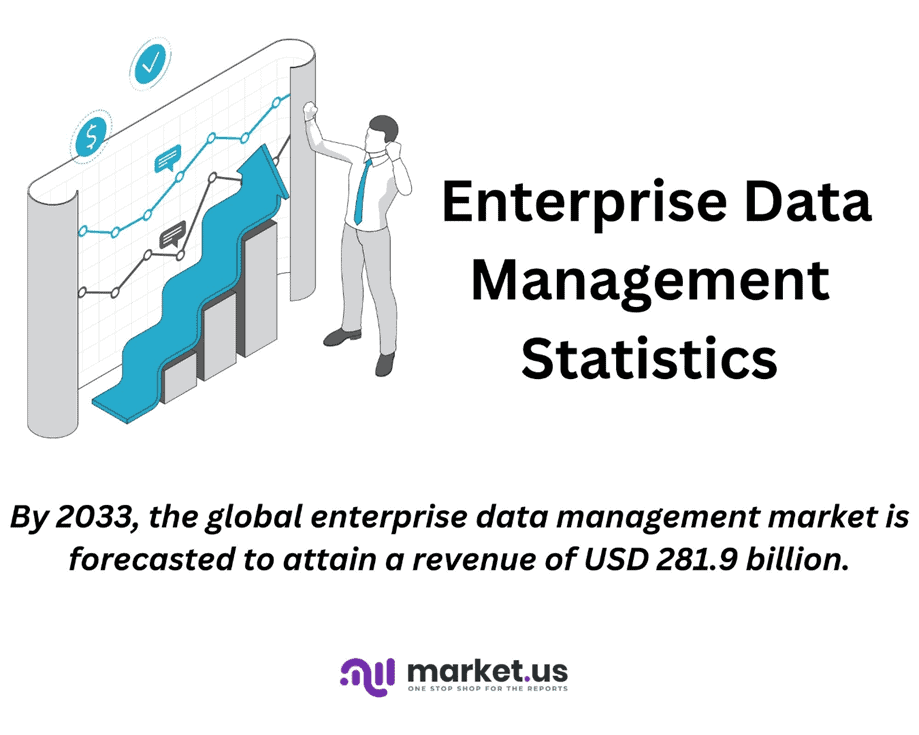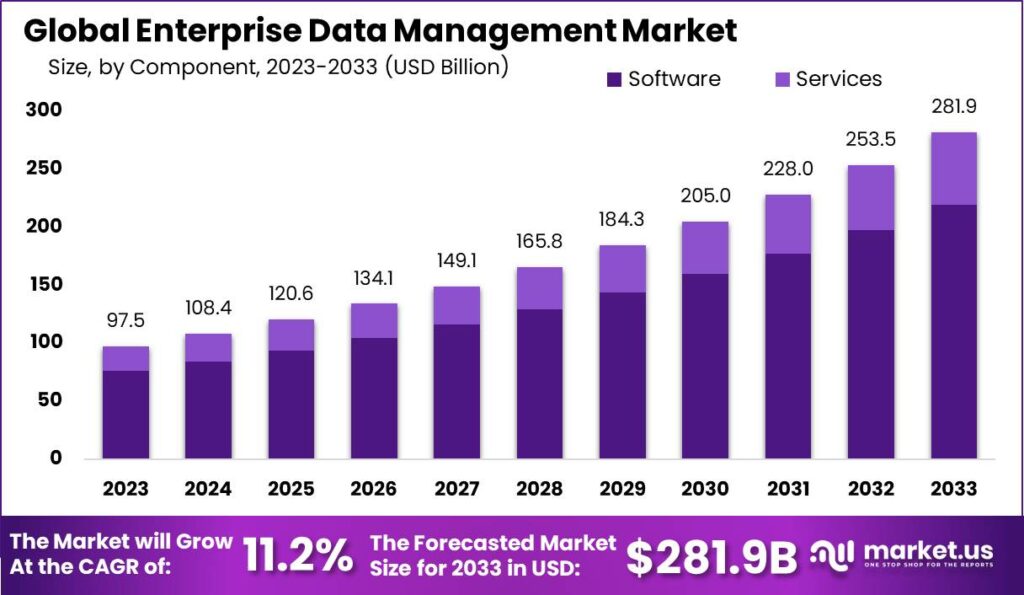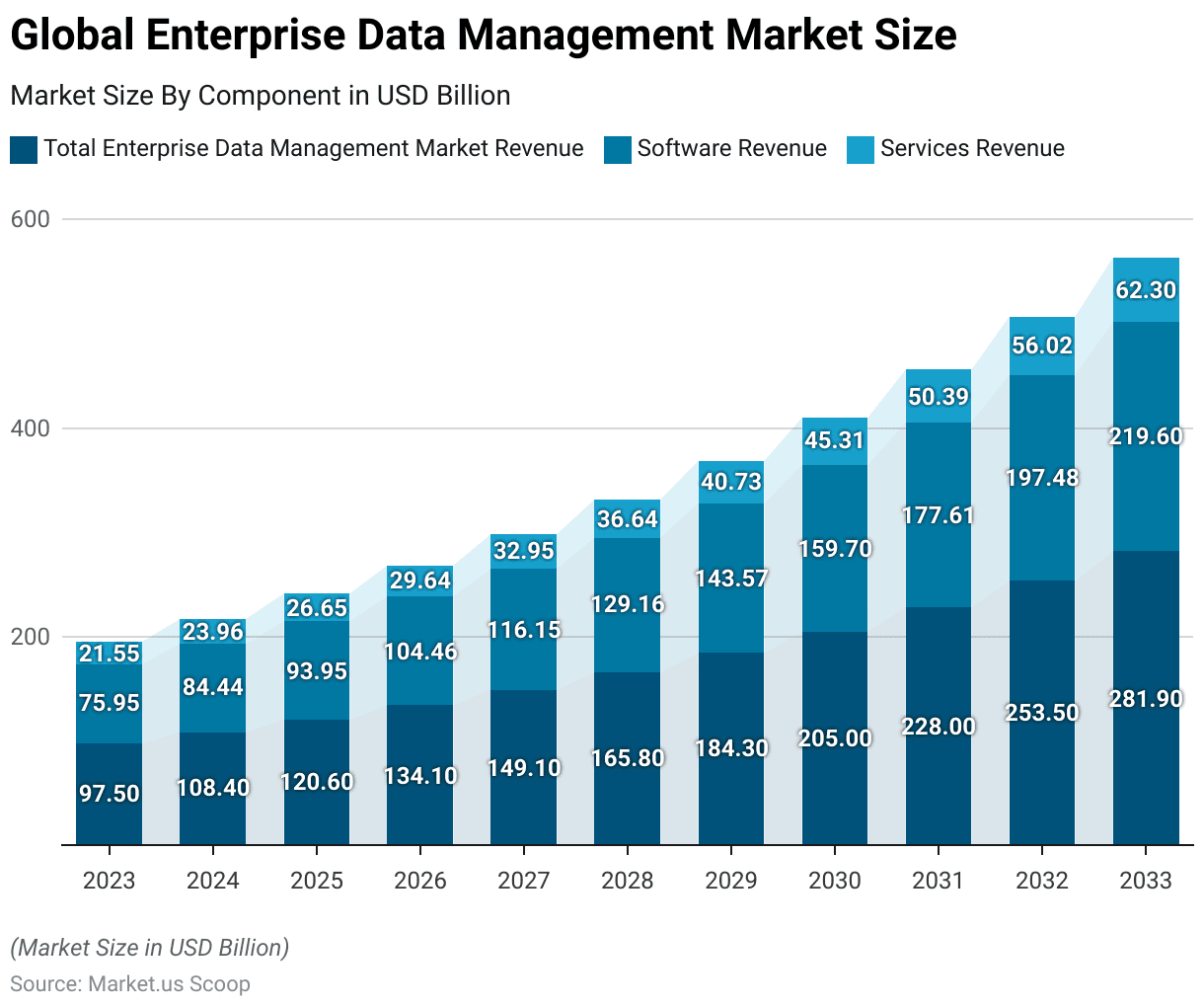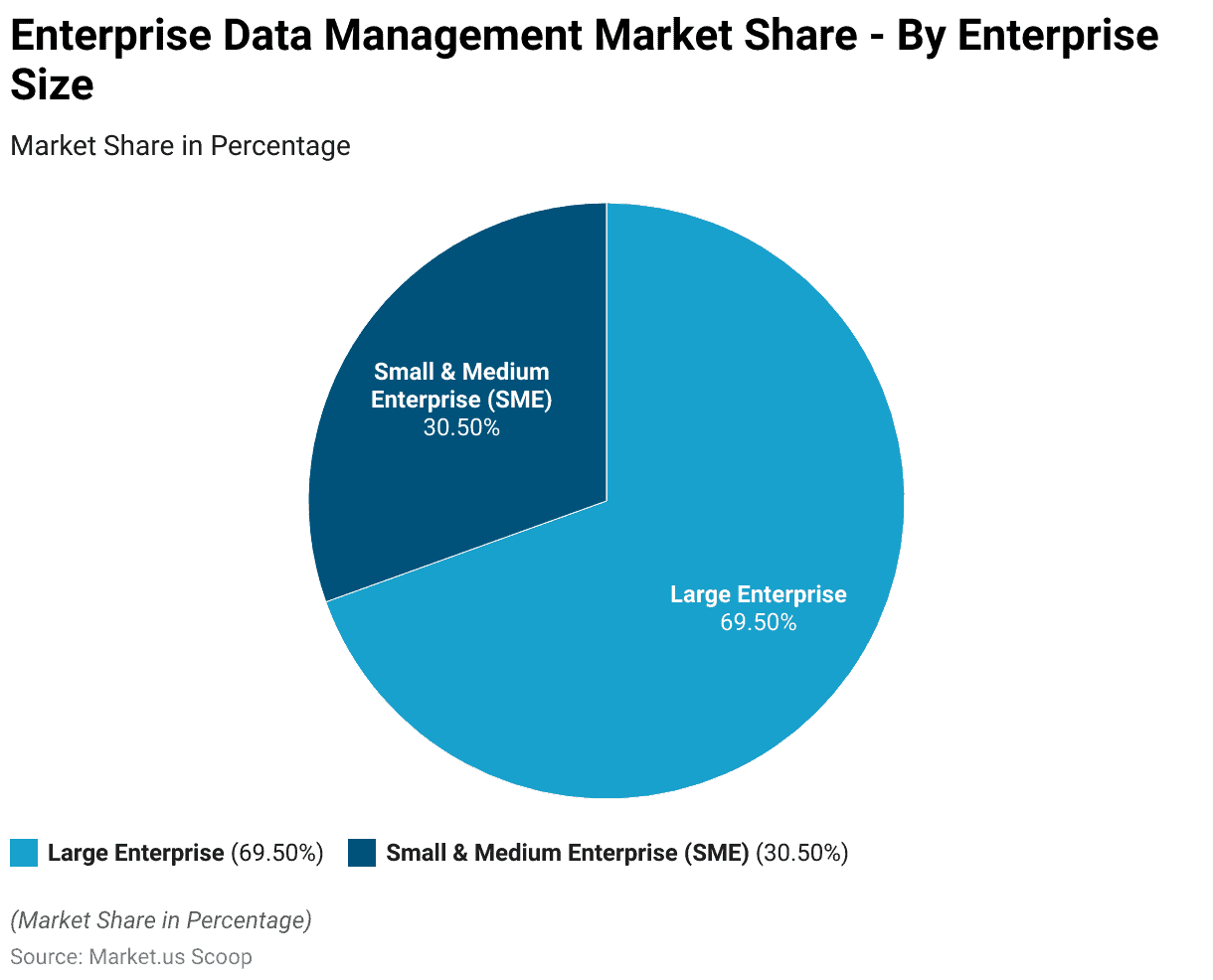Table of Contents
- Introduction
- Editor’s Choice
- Global Enterprise Data Management Market Overview
- Amount of Data Generated Daily
- Global Enterprise Data Volume Statistics
- Challenges Driving the Demand for Effective EDM
- Data Management Strategies Employed by Enterprises
- Various Solutions Adopted by Enterprises for Effective EDM
- Average Response Time and Lifecycle in Data Breaches
- Data Management Platform Pricing
- Emerging Enterprise Data Management Technologies Statistics
- Recent Developments
- Conclusion
- FAQs
Introduction
Enterprise Data Management Statistics: Enterprise Data Management (EDM) is essential for managing crucial business data through practical methods, processes, and tech frameworks. It aims to achieve data accuracy, security, and consistency to aid decision-making and efficiency.
Critical aspects of EDM include data governance, quality, integration, security, master data management, and metadata management.
Implementing EDM enhances decision-making, operational efficiency, compliance, and data visibility. However, challenges like data silos, quality maintenance, change management, and technological complexity must be navigated.
Despite obstacles, adopting EDM is crucial for companies to utilize data for a competitive edge, ensuring reliability and strategic insights.

Editor’s Choice
- The global Enterprise Data Management (EDM) market revenue is expected to rise from USD 97.5 billion in 2023 to USD 281.9 billion by 2033.
- The software segment, which constitutes a significant portion of the market, is projected to grow from USD 75.95 billion in 2023 to USD 219.6 billion by 2033.
- Large enterprises hold a substantial portion of the market, accounting for 69.50%. Underscoring their significant investment in and reliance on EDM solutions to effectively manage vast amounts of data.
- Projections suggest that by 2020, each person will contribute to creating 1.7MB of data every second.
- Internally managed data centers increased from 297 terabytes in 2020 to 570 terabytes in 2022, marking the highest growth among the categories.
- The KPMG Real Estate Data Strategy Survey builds upon insights from the 2019 KPMG Global PropTech Survey. Revealed that 57% of those surveyed have implemented a coordinated data strategy.
- Enterprises have embraced various solutions to enhance their enterprise data management practices. The most widely adopted solution, with 92% of enterprises implementing it, is data governance.

Global Enterprise Data Management Market Overview
Global Enterprise Data Management Market Size Statistics
- The global Enterprise Data Management (EDM) market has demonstrated a strong growth trajectory, with revenue projections indicating a significant increase over the next decade at a CAGR of 11.2%.
- Starting from USD 97.5 billion in 2023, the market is expected to rise steadily, reaching USD 108.4 billion in 2024.
- This growth trend is anticipated to continue, with the market size expanding to USD 120.6 billion in 2025, USD 134.1 billion in 2026, and further to USD 149.1 billion in 2027.
- By 2028, the EDM market is projected to hit USD 165.8 billion, followed by an increase to USD 184.3 billion in 2029.
- The upward momentum is expected to carry forward into the next decade, with market revenues reaching USD 205.0 billion in 2030, USD 228.0 billion in 2031, USD 253.5 billion in 2032, and finally culminating at USD 281.9 billion by 2033.
- This consistent growth underscores the increasing recognition of the importance of data management within the global business landscape, highlighting a robust demand for EDM solutions.
(Source: Market.us)

Global Enterprise Data Management Market Size – By Component Statistics
- The Global Enterprise Data Management (EDM) Market has exhibited robust growth, with total market revenue expected to rise from USD 97.5 billion in 2023 to USD 281.9 billion by 2033. Both software and service components drive this growth.
- The software segment, which constitutes a significant portion of the market, is projected to grow from USD 75.95 billion in 2023 to USD 219.6 billion by 2033.
- Meanwhile, the services segment also shows strong growth, with revenues increasing from USD 21.55 billion in 2023 to USD 62.3 billion in 2033.
- This consistent growth across both segments underscores the increasing reliance on and investment in EDM solutions to meet the evolving needs of enterprises globally. Highlighting the sector’s critical role in enhancing data management capabilities and supporting business operations.
(Source: Market.us)

Global Enterprise Data Management Market Share – By Enterprise Size Statistics
- In the Global Enterprise Data Management (EDM) market, a distinct distribution in market share by enterprise size is observed.
- Large enterprises hold a substantial portion of the market, accounting for 69.50%. Underscoring their significant investment in and reliance on EDM solutions to effectively manage vast amounts of data.
- On the other hand, Small and Medium Enterprises (SMEs) represent 30.50% of the market share.
- This indicates that while smaller in scale than large enterprises. SMEs also recognize the importance of investing in EDM technologies to optimize their data management practices and support business growth.
- This distribution highlights the broad appeal and necessity of EDM solutions across different scales of business operations.
(Source: Market.us)
Take advantage of our unbeatable offer - buy now!


Amount of Data Generated Daily
- Every day, the world sees a massive influx of data across various platforms: 500 million tweets are posted, 294 billion emails are dispatched, and Facebook generates 4 petabytes of data.
- Each connected car contributes four terabytes of data, while WhatsApp sees 65 billion messages exchanged. Additionally, 5 billion searches are conducted daily.
- Looking ahead to 2025, it’s projected that the global daily data creation will reach 463 exabytes. Equal to about 212.8 million DVDs each day.
- Studies indicate that over 2.5 quintillion bytes of data are generated daily, with this vast amount of information expanding rapidly.
- Projections suggest that by 2020, each person will contribute to creating 1.7MB of data every second.
(Source: World Economic Forum, Northeastern University)
Global Enterprise Data Volume Statistics
- Between 2020 and 2022, the total volume of enterprise data worldwide experienced significant growth across various locations, measured in terabytes.
- Internally managed data centers increased from 297 terabytes in 2020 to 570 terabytes in 2022, marking the highest growth among the categories.
- Cloud repositories, including public, private, and industry-specific clouds. Also witnessed substantial growth, with data volumes expanding from 221 terabytes to 498 terabytes within the same period.
- Third-party data centers’ data volume grew from 201 terabytes to 407 terabytes. While data stored in edge and remote locations increased from 193 terabytes to 390 terabytes.
- Additionally, volumes in other locations rose from 89 terabytes in 2020 to 160 terabytes in 2022.
- This overall growth underscores the expanding scale of data management needs across different storage solutions and geographical locations. Reflecting the dynamic nature of enterprise data storage and management in the digital era.
(Source: Statista)

Challenges Driving the Demand for Effective EDM
- A 2004 Gartner report titled “CRM Demands Data Cleansing” surveyed 600 large enterprises in Australia, the UK, and the US, revealing substantial issues due to poor data quality.
- Three-quarters of those surveyed acknowledged facing severe challenges due to inaccurate data.
- Over half of the respondents experienced additional expenses from conducting internal reconciliations.
- Additionally, 33% encountered problems with billing or collecting payments, with a third of participants reporting some form of billing or collections issue attributable to substandard data.
- A significant 76% of those surveyed expressed difficulties in comprehending their data. In comparison, 82% of those responsible for data management decisions found managing and predicting data-related costs challenging.
- Approximately 80% cited the absence of data cataloging as a primary concern.
- Furthermore, as much as 82% of participants identified the complexity of data governance policies as a significant obstacle.
- As businesses accumulate increasing amounts of data, effective data governance becomes essential to ensure data remains relevant, easily accessible, usable, and capable of delivering business value. Especially as companies transition to cloud-based operations.
- Industry-wide research indicates that, on average, organizations utilize less than half of their structured data for decision-making purposes, and barely 1% of unstructured data is ever analyzed or utilized.
- Furthermore, over 70% of employees can access data they shouldn’t. While analysts dedicate approximately 80% of their time to finding and preparing data.
(Source: Gartner, Forbes, Harvard Business Review)
Data Management Strategies Employed by Enterprises
- The KPMG Real Estate Data Strategy Survey builds upon insights from the 2019 KPMG Global PropTech Survey. Revealed that 57% of those surveyed have implemented a coordinated data strategy.
- However, only 28% of participants leverage data to enhance tenant experiences. This factor KPMG suggests is crucial for boosting customer satisfaction and should thus be a priority for real estate owners and operators.
- Interestingly, while 75% of respondents rely on Excel for analytics, 69% acknowledge an overdependence on the software.
- Around 30% of the survey participants outsource at least a portion of their data management. Whereas 39% utilize a centralized data repository for storing and accessing data. This figure jumps to 60% among larger firms.
- Additionally, the shift towards remote working prompted by COVID-19 has expedited the data strategy implementation plans for 34% of the respondents.
(Source: KPMG)
Various Solutions Adopted by Enterprises for Effective EDM
- Enterprises have embraced various solutions to enhance their enterprise data management practices. The most widely adopted solution, with 92% of enterprises implementing it, is data governance.
- This is followed by data stewardship and data quality management. Both were utilized by 67% of respondents, indicating a strong focus on maintaining data integrity and quality.
- Similarly, 67% of enterprises have adopted master reference data management to ensure consistency across their data assets.
- Data warehousing and business intelligence tools are employed by 46% of enterprises to support data analysis and reporting.
- Data preparation for business users and data discovery are adopted by 40% and 23% of respondents, respectively. Highlighting the emphasis on making data accessible and understandable for non-technical users.
- Less common solutions include data warehouse automation (19%), data lakes (17%), and data integration (15%), which facilitate streamlined data processing and storage.
- Holistic data platforms and self-service analytics, are each utilized by 10% of enterprises. Reflect a trend toward empowering users with comprehensive data tools and autonomous analytical capabilities.
- Other solutions, such as data virtualization, data storage/provisioning, and advanced analytics, including machine learning and artificial intelligence, are less frequently adopted, ranging from 8% to 6% in usage.
- The least common technologies, including a query engine, data pipelining, cloud integration, and data fabric, are used by 4% or less of the enterprises surveyed. Indicating niche applications or emerging trends within enterprise data management.
(Source: Dataspot)

Average Response Time and Lifecycle in Data Breaches
- On a global scale, detecting a data breach typically requires about 204 days on average.
- Organizations employing threat intelligence detected threats approximately 28 days quicker than those not using it.
- Once identified, the average duration to effectively contain a breach spanned 73 days.
- Incidents involving stolen or compromised credentials were the most time-consuming to address. Taking an average of 88 days to resolve, leading to a total data breach lifecycle of 328.
- Interestingly, breaches with a lifecycle shorter than 200 days incurred costs that were, on average, $1.02 million lower than those extending beyond 200 days.
(Source: IBM)
Data Management Platform Pricing
- The cost of a Data Management Platform (DMP) largely hinges on its range of features and functionalities. DMPs assist marketers in gathering and organizing data, enabling them to make informed decisions that boost sales and conversion rates.
- In 2018, U.S. marketers allocated almost $5 billion towards data management solutions, marking a growth of over 25%.
- Additionally, 24% of marketers plan to dedicate their budgets to DMP investments in the coming year.
- Typically, a Data Management Platform (DMP) pricing begins at $1,100 and can escalate to $6,000 monthly or even higher.
Emerging Enterprise Data Management Technologies Statistics
- Companies adopting new technologies often grapple with the role of older, yet still valuable, legacy systems. Such systems, include enterprise resource planning (ERP) solutions like SAP or Oracle. May seem outdated but continues to support critical business functions.
- Many legacy systems provide extensive master data management (MDM) capabilities for cloud and on-premises implementations. Enterprises increasingly integrate these MDM tools into their data governance frameworks, recognizing their ongoing utility.
- The adoption of artificial intelligence (AI) and machine learning (ML) in data management, driven by the challenges of managing vast amounts of data amid a tech industry-wide staffing shortage, particularly in data-centric roles, continues to rise.
- AI/ML technologies are revolutionizing traditional manual and error-prone processes by automating foundational data management tasks like data identification and classification more efficiently and accurately.
- Enterprises leverage AI/ML for advanced data management functions, including data catalog, metadata management, data mapping, anomaly detection, metadata auto-discovery, and monitoring data governance controls.
- Distributed ledger and blockchain technologies offer enterprises enhanced security for transaction records, asset tracking, and audit trails by storing data in an unalterable, decentralized format. This improves the authenticity and accuracy of various documents, from financial transactions to sensitive data activities.
- Blockchain enhances data management by boosting data security, shareability, consistency, and automatic verification, strengthening data governance and security measures.
(Source: Datamation)
Recent Developments
Acquisitions and Mergers:
- Salesforce’s Acquisition of Informatica: In April 2024, Salesforce entered advanced discussions to acquire Informatica, a leading cloud-based data management services provider. This acquisition, valued at approximately $11.35 billion, aims to enhance Salesforce’s data management capabilities.
- Capgemini’s Acquisition of Syniti: In September 2024, Capgemini announced its acquisition of Syniti, a data management solutions provider. This strategic move is expected to strengthen Capgemini’s position in the EDM market, particularly in SAP data migrations.
- Five Arrows’ Acquisition of Rimes: In April 2024, Five Arrows acquired Rimes, an EDM-as-a-Service and investment platform solutions provider. This acquisition aims to accelerate Rimes’ global expansion in the EDM sector.
New Product Launches:
- Oracle’s Data Management Innovations: In September 2023, Oracle expanded its data management offerings by enhancing autonomous database capabilities and accelerating database software innovation. These advancements aim to improve enterprise data integration and security.
Funding:
- Rubrik’s Series E Funding: In January 2019, Rubrik raised $261 million in Series E funding, bringing its valuation to $3.3 billion. The funds are intended to expand Rubrik’s presence in new data management markets and support the launch of new products.
Conclusion
Enterprise Data Management Statistics – In conclusion, Enterprise Data Management (EDM) is a critical framework that underpins the strategic handling of data across organizations.
It encompasses many practices, from data governance and quality to security and integration, to ensure data accuracy, accessibility, and security.
The adoption of EDM enables businesses to make informed decisions, improve operational efficiency, and maintain a competitive edge in today’s data-driven landscape.
Despite facing challenges like data silos and integration complexities, the strategic implementation of EDM practices is indispensable for leveraging data as a valuable asset, ensuring its relevance, usability, and contribution to business value as companies continue to evolve and adapt in the digital era.
FAQs
Enterprise Data Management is a comprehensive approach to managing an organization’s data, ensuring it is accurate, accessible, secure, and consistent across all business units. It encompasses practices and processes for data governance, quality, integration, security, and storage.
EDM is crucial for making informed business decisions, enhancing operational efficiency, ensuring data privacy and regulatory compliance, and maintaining a competitive edge. It helps in managing the integrity and usability of data across the enterprise.
The critical components of EDM include data governance (establishing policies and standards for data management), data quality (ensuring data accuracy and consistency), data integration (combining data from various sources), data security (protecting data from unauthorized access), and master data management (creating a single source of truth for critical business data).
EDM benefits an organization by improving decision-making capabilities, enhancing operational efficiency, ensuring compliance with data regulations, protecting against data breaches, and enabling better customer experiences through high-quality data.
Challenges in implementing EDM include overcoming data silos, ensuring data quality across diverse data sources, managing data privacy and security, and integrating complex data systems. Additionally, cultural and organizational changes may be required to adopt EDM practices effectively.
Discuss your needs with our analyst
Please share your requirements with more details so our analyst can check if they can solve your problem(s)



